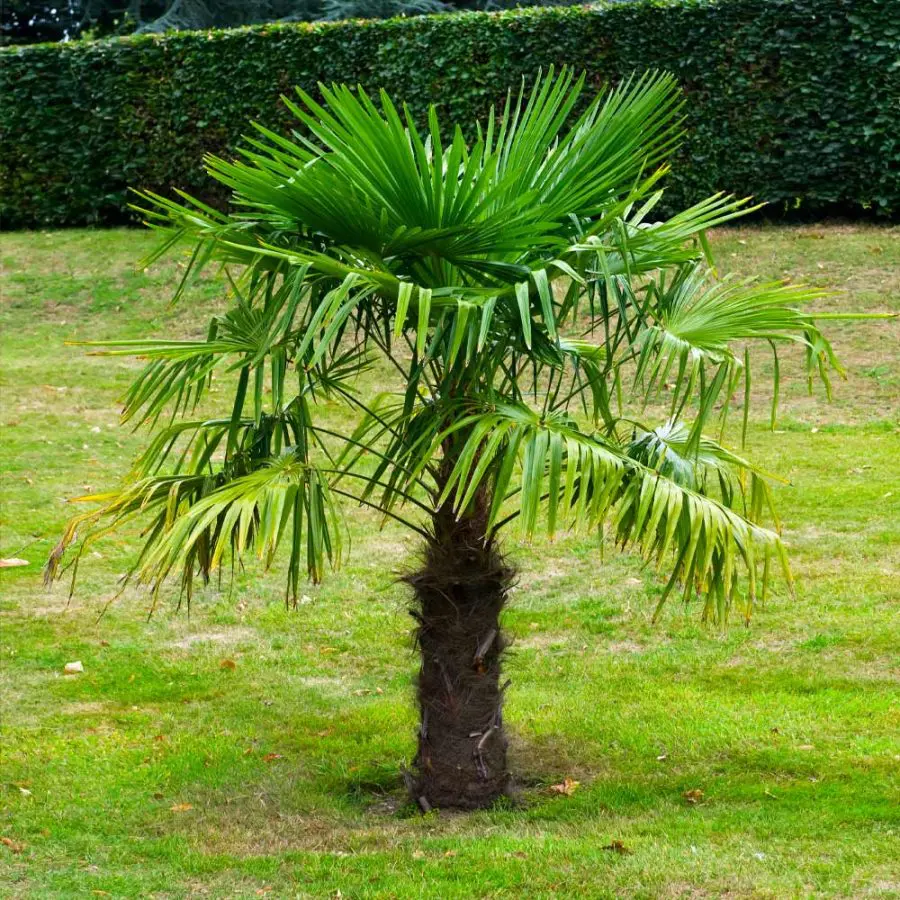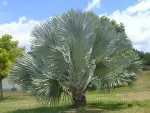This post contains affiliate links. If you buy something from one of our links we may earn a commission. Thanks

Want to grow a gorgeous windmill palm? Learn everything you need to know about windmill palm care, whether in containers or outdoors!
Windmill Palm care primarily involves selecting well-draining soil, regular watering without waterlogging the soil, and using a slow-release palm-specific fertilizer. It’s adaptable to various light conditions but prefers partial shade. Whether planted in containers or outdoors, ensuring frost protection in winter and monitoring for pests and diseases are crucial for healthy growth.
Are you ready to elevate your garden game with a stunning windmill palm? Look no further than our guide to windmill palm care!
Whether you’re growing them in containers or outdoors, we’ve got you covered with all the tips and tricks you need to keep your palms healthy and thriving.
From choosing the right container to managing pests, we’ve got everything you need to make your windmill palm the envy of the neighborhood!
You can get your windmill palm here On Amazon
I. Introduction
In this guide, we will explore the fascinating world of windmill palm trees, a popular and stunning plant that can add a touch of exotic beauty to any garden or outdoor space.
Whether you’re a seasoned gardener or a newbie plant enthusiast, this comprehensive guide to windmill palm care will provide you with all the essential information you need to grow these palms successfully.
We’ll cover the advantages of growing windmill palms in containers as well as the optimal conditions for growing them outdoors in the right climate.
So, let’s dive in and discover all there is to know about windmill palm care!
What Is A Windmill Palm?
Windmill palms, also known as Trachycarpus fortunei, are a popular choice among gardeners and landscapers because of their striking appearance and adaptability to a variety of climates.
They are also called Chusan Palm and Chinese Windmill palm. These palms are native to China and have a slow growth rate, reaching up to 40 feet in height over the course of several decades.
The unique shape of their leaves resembles the blades of a windmill, hence the name.
Windmill palms can be grown in containers or planted in the ground, depending on your preferences and the climate of your area.
According to Wikipedia:Trachycarpus fortunei, the Chinese windmill palm, windmill palm or Chusan palm, is a species of hardy evergreen palm tree in the family Arecaceae, native to parts of China, Japan, Myanmar and India.
B. Advantages of growing windmill palms in containers:
One of the biggest advantages of growing windmill palms in containers is that they can be easily moved from one location to another.
This makes them an excellent option for gardeners who want to experiment with different layouts or move their plants to areas with better sunlight or shade.
Containers also provide more control over the soil conditions, ensuring that the palms get the right amount of moisture and nutrients.
Additionally, windmill palms grown in containers are generally smaller in size, making them a great choice for balconies, patios, or other small outdoor spaces.
C. Advantages of growing windmill palms outdoors in the right climate:
Growing windmill palms outdoors in the right climate can be a great option for those who have the space and live in an area with a moderate climate.
These palms can grow up to 40 feet tall, making them an excellent addition to any landscape.
They also require less maintenance than palms grown in containers, as they can naturally obtain the necessary nutrients from the soil.
Windmill palms are also relatively low maintenance and can be left alone for extended periods without causing harm to the plant.
In addition to their beauty, windmill palms can also provide shade, privacy, and a home for wildlife such as birds and squirrels.
Windmill Palm Quick Facts
| Mature Height: | 20-40 ft |
| Mature Width: | 6-15 ft |
| Sunlight: | Full-Partial |
| Growth Rate: | Slow |
| Botanical Name: | Trachycarpus fortunei |
| Grows Well In Zones: | 7-10 outdoors |
You can get your windmill palm here On Amazon
What climate zones are suitable for growing outdoors
Windmill palms can be grown outdoors in areas with a moderate climate, typically in USDA hardiness zones 7b to 11.
These areas include southern and coastal regions of the United States, such as Florida, Georgia, the Carolinas, and parts of Texas, as well as California and other parts of the West Coast.
In these areas, the temperatures usually stay above 10 to 15 degrees Fahrenheit, which is the minimum temperature that windmill palms can tolerate.
However, it’s important to note that windmill palms can still be vulnerable to extreme cold, so it’s recommended to protect them with a cover or move them indoors during the coldest months of the year.
There are many examples of the windmill palm growing outdoors in the pacific northwest. I have seen some really large ones growing in Seattle.
You can get your windmill palm here On Amazon
II. Growing Windmill Palms in Containers
Growing windmill palms in containers can be a great way to add a touch of tropical beauty to your patio, balcony, or indoor space.
While they may require a bit more attention than those planted directly in the ground, container-grown windmill palms offer greater flexibility in terms of location and can be a perfect choice for those living in cooler climates.
In this section of our guide to windmill palm care, we’ll explore everything you need to know to successfully grow windmill palms in containers.
From choosing the right pot to fertilizing and pruning, we’ve got you covered!
A. Choosing the right container:
When choosing a container for your windmill palm, there are a few important factors to consider to ensure that your palm stays healthy and happy:
Material: The material of the container should be sturdy and able to withstand the weight of the soil and plant. Plastic and terracotta are popular choices.
Size: Choose a container that is large enough to accommodate the palm’s roots as it grows.
A general rule of thumb is to choose a container that is 2 to 4 inches larger in diameter than the plant’s root ball.
Drainage: Proper drainage is crucial for container-grown windmill palms. Choose a container with drainage holes in the bottom to allow excess water to escape.
B. Potting mix:
The right potting mix is essential for the health and growth of your windmill palm.
Choose a well-drained soil mix that is rich in organic matter, such as peat moss, perlite, and compost.
Avoid using heavy soils that can lead to root rot. A coco coir and perlite mix is a good choice for container-grown palms.
Coco Coir and Perlite Mix
A coco coir and perlite mix can be a great choice for growing windmill palms in containers.
Coco coir is a renewable and sustainable growing medium made from coconut fibers, which makes it an environmentally friendly choice for gardeners.
It’s also a lightweight and well-draining material, which can help prevent overwatering and promote healthy root growth.
Perlite is a lightweight volcanic rock that can be mixed into the soil or growing medium to help improve drainage, aeration, and soil structure. It can also help prevent soil compaction and provide some insulation for the plant roots.
When mixed together in the right proportion, coco coir and perlite can create a well-draining, moisture-retaining growing medium that can provide the right amount of support and moisture for container-grown windmill palms.
You can experiment using 25-50% perlite in the mix. More perlite means faster drainage but also requires more frequent watering.
Why it’s better than peat moss
Coco coir is often considered a better alternative to peat moss for several reasons.
First, peat moss is often harvested from wetland ecosystems, which can be damaging to the environment.
In contrast, coco coir is made from the fibers of coconut husks, which are a renewable resource.
Second, coco coir has a more neutral pH than peat moss, which can be quite acidic. This can be beneficial for plants that prefer a more neutral or alkaline soil pH.
Finally, coco coir has excellent water retention properties, which can help plants stay hydrated and healthy without becoming waterlogged.
Peat moss can also retain water, but it can be difficult to rehydrate once it dries out, which can be a problem for container-grown plants that need consistent moisture.
Overall, while peat moss can be a suitable growing medium for some plants, many gardeners prefer to use coco coir because of its renewable and sustainable properties, neutral pH, and excellent water retention capabilities.
Lighting

Windmill palm trees are adaptable as far as lighting goes although they do actually prefer some shade.
So plant them in partial shade, where they will receive two to four hours of direct sunlight per day.
Windmill palms can be grown in full sun, but in hotter and drier climates, they may benefit from some protection from the mid-day sun, especially when they are young or newly planted.
In cooler or more temperate climates, windmill palms can be grown in full sun without issue.
However, in general, windmill palms prefer bright, filtered sunlight, rather than direct, intense sunlight.
Outdoors, they can be planted in partial shade or partially sunny areas, while if you’re growing a windmill palm indoors, it should be placed in a bright, sunny room with indirect sunlight, such as near a window with a sheer curtain or in a well-lit corner of the room.
It’s also important to note that young windmill palms may be more sensitive to sunlight and may require more shade or protection from direct sunlight than more established plants.
As with all plants, it’s important to observe how your windmill palm responds to its environment and adjust its location or shade as needed.
C. Watering:
Proper watering is crucial for the health of your windmill palm, but it can be a delicate balance. Here are some tips to keep in mind:
Frequency:
Water your palm when the top inch of soil feels dry to the touch. In general, container-grown palms need more frequent watering than those planted in the ground.
Amount:
Water your palm thoroughly, allowing the water to drain out of the bottom of the container. Avoid over-watering, which can lead to root rot.
D. Fertilization:
Fertilizing your windmill palm can help it grow healthy and strong. Choose a slow-release fertilizer that is specifically formulated for palms and follow the instructions on the package.
The use of tree spikes will take the guesswork out of fertilizing. Here is what I recommend for  fertilizing your windmill palm.
fertilizing your windmill palm.
I recommend using Jobes Organics fertilizer spikes.
They are easy to use and last for 2-3 months.
They are designed for container-grown citrus but they work great for palms too.
Using 2 spikes for a 12-inch pot or 3 for an 18-inch pot takes the guesswork out of fertilizing.
They provide a 3-5-5 fertilizer blend along with micronutrients and beneficial bacteria.
E. Pruning:
Pruning your windmill palm can help keep it healthy and looking its best.
Remove any dead or yellowing fronds, as well as any fruit or flowers that may be growing. Be sure to use clean, sharp tools to avoid damaging the plant.
F. Repotting:
As your windmill palm grows, it may outgrow its container and need to be repotted.
Signs that it’s time to repot include roots growing out of the drainage holes, the soil drying out quickly, or the plant becoming top-heavy.
When repotting, choose a container that is one size larger than the current one, and use fresh potting mix.
III. Growing Windmill Palms Outdoors

Growing windmill palms outdoors can add a touch of tropical paradise to your landscape.
With their unique, fan-like leaves and low-maintenance nature, windmill palms are a popular choice for those living in the right climate zones.
In this section of our guide to windmill palm care, we’ll cover everything you need to know to successfully grow windmill palms outdoors, from planting to pruning.
Whether you’re a seasoned gardener or just starting out, with a little bit of know-how, you can enjoy the beauty and benefits of windmill palms in your own backyard.
A. Climate considerations:
Windmill palms are hardy and can tolerate a wide range of temperatures, but they do have some specific climate requirements.
They are best suited to USDA hardiness zones 7 through 11, which have mild to hot summers and relatively mild winters.
They can tolerate temperatures down to around 10 degrees Fahrenheit, but if temperatures dip below this, it’s important to protect your palm with frost cloth or other protective coverings.
B. Soil requirements:
Windmill palms prefer well-draining soil that is rich in organic matter.
They can tolerate a range of soil types, including sandy, loamy, and clay soils, but they do not like soil that is constantly wet or soggy.
If your soil is heavy or poorly draining, consider amending it with compost or other organic matter.
C. Sunlight and water requirements:
Windmill palms thrive in partial to full sunlight, but they can also tolerate shade.
They need regular watering, especially during hot, dry weather. Water deeply, but avoid over-watering, which can lead to root rot.
Mulching around the base of the palm can help retain moisture in the soil.
D. Fertilization:
Windmill palms benefit from regular fertilization, especially in the growing season. Use a slow-release, palm-specific fertilizer and follow the instructions on the package.
Over-fertilization can lead to salt buildup in the soil, so be sure not to overdo it.
E. Pruning:
Pruning is not usually necessary for windmill palms, but it can be done to remove dead or yellowing fronds or to shape the palm to your liking.
Avoid removing too many fronds at once, as this can stress the plant. Be sure to use clean, sharp tools to avoid damaging the plant.
F. Disease and pest management:
Windmill palms are relatively disease-resistant, but they can be susceptible to a few pests, including spider mites and scale insects.
Regularly inspect your palm for any signs of infestation, such as yellowing leaves or sticky residue on the fronds.
Treat any infestations promptly with insecticidal soap or neem oil.
IV. Windmill Palm FAQs
For individuals curious about nurturing Windmill Palms, common inquiries often arise.
Here are some frequently asked questions and their respective answers to guide you on your gardening journey:
Q. What are the ideal climate conditions for growing Windmill Palms?
A. Windmill Palms thrive in USDA hardiness zones 7b to 11, which offer mild to hot summers and mild winters. They can tolerate temperatures down to around 10°F but require protection or moving indoors during colder periods.
Q. What type of soil is best suited for Windmill Palms?
A. Well-draining soil rich in organic matter is ideal. They can adapt to sandy, loamy, or clay soils, but avoid constantly wet or soggy conditions. Amending poor draining soil with compost or other organic matter is advisable.
Q. How often should I water my Windmill Palm?
A. Watering should be done when the top inch of soil feels dry. The frequency varies with the weather and the setup (outdoors or container); however, over-watering leading to waterlogged soil should be avoided to prevent root rot.
Q. How do I protect my Windmill Palm from pests and diseases?
A. Regular inspection for signs of infestations like yellowing leaves or sticky residue is key. If infested, treating with insecticidal soap or neem oil can help. Maintaining a well-draining soil also prevents root rot, a common issue.
V. Windmill Palm Care Final Thoughts
We hope this guide to windmill palm care has been helpful in providing you with the information you need to successfully grow and care for your own windmill palm.
Whether you choose to grow your palm in a container or outdoors, in the right climate zone, windmill palms can bring a touch of tropical beauty to your home or garden.
Remember to choose the right container, soil, and fertilizer for your palm, and to provide it with regular watering and care.
With a little bit of patience and know-how, you can enjoy the beauty and benefits of this stunning plant for years to come!
Recap
To summarize the key points of this guide to windmill palm care, it’s important to choose the right container or planting location, soil, and fertilizer for your palm.
Regular watering, pruning, and fertilization are also important to keep your palm healthy and looking its best.
Windmill palms can be grown in containers or outdoors in the right climate zones, and they are relatively low-maintenance plants that can add a touch of tropical beauty to any home or garden.
B. Final tips and tricks:
Some final tips and tricks for growing windmill palms include:
• Choose a well-draining soil and avoid over-watering to prevent root rot.
• Use a slow-release, palm-specific fertilizer to avoid over-fertilization.
• Prune your palm sparingly and with clean, sharp tools to avoid damaging the plant.
• Protect your palm from frost and cold temperatures in the winter.
• Regularly inspect your palm for signs of pests or disease and treat promptly if necessary.
C. Encouragement for new growers:
If you’re a new grower, don’t be intimidated by the prospect of growing a windmill palm!
With a little bit of patience and attention to detail, you can successfully care for your palm and enjoy the beauty and benefits it provides.
Remember to start with a healthy plant and choose the right location and soil for your palm, and don’t be afraid to reach out to local gardening resources or online forums for support and advice.
Growing windmill palms can be a rewarding and enjoyable experience, so don’t be afraid to give it a try!
You can get your windmill palm here On Amazon
Learn more: Indoor Palm Tree Care: 11 Powerful Tips Complete Guide For Beginners








